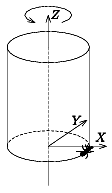 |
Exercises and problems in Informatics |
Please read The Conditions of the Problem Solving Competition.
I. 34. Binomial coefficients can be
used to represent natural numbers in the so-called binomial base. For
a fixed m (2\(\displaystyle \le\)m \(\displaystyle \le\)50) every natural number n (0 n
n 10000) can uniquely
be represented as
10000) can uniquely
be represented as
\(\displaystyle n={a_1\choose1}+{a_2\choose2}+\dots+{a_m\choose m}\), where 0 a1<a2<...<am.
a1<a2<...<am.
Your program (I34.pas, ...) should read the numbers n and m, then display the corresponding sequence a1,a2,...,am.
Example. Let n=41, then a1=1,a2=2,a3=4,a4=7, because
\(\displaystyle 41={1\choose1}+{2\choose2}+{4\choose3}+{7\choose4}=1+1+4+35.\)
(10 points)
I. 35. We put an ant close beside the base of a cylinder-jacket with radius R and height H. In every minute the ant creeps upwards M centimetres. The cylinder is rotated around its axis (which is just the Z-axis) anticlockwise completing T turns per minute. The ant starts from the point (R,0,0), and we are watching it at an angle of ALPHA degree relative to the Y-axis, see the figure.
 |  |
| 1. ábra | 2. ábra |
Write your program (I35.pas, ...) which reads the
values of R (1\(\displaystyle \le\)R\(\displaystyle \le\)50), H (1\(\displaystyle \le\)H\(\displaystyle \le\)200), M (1\(\displaystyle \le\)M\(\displaystyle \le\)H), T (1 T
T 100) and ALPHA
(0\(\displaystyle \le\)ALPHA<90), then displays the axonometric
projection to the plane Y=0 of the path of the ant using
continuous line on the visible side of the cylinder and dotted line on
the back side.
100) and ALPHA
(0\(\displaystyle \le\)ALPHA<90), then displays the axonometric
projection to the plane Y=0 of the path of the ant using
continuous line on the visible side of the cylinder and dotted line on
the back side.
Example. Figure 2 shows the path of the ant with R=50, H=200, M=1, T=40, ALPHA=30. (10 points)
I. 36. According to the trinomial theorem
\(\displaystyle {(x+y+z)}^n=\sum_{\textstyle{0\le a,b,c\le n\atop a+b+c=n}} {a+b+c\choose a,b,c}x^ay^bz^c. \)
The trinomial coefficients can be computed, for example, by the formula
\(\displaystyle {a+b+c\choose a,b,c}=\frac{(a+b+c)!}{a!b!c!}. \)
However, these factorials can be very large, thus
their direct computation is not always feasible. Nevertheless, writing
trinomial coefficients as a product of binomial coefficients can
settle this problem. Prepare your sheet (I36.xls) which, if n
(n=a+b+c, n 20) is entered into
a given cell, displays a table of trinomial coefficients, similar to
the one below.
20) is entered into
a given cell, displays a table of trinomial coefficients, similar to
the one below.
|
The example shows the coefficients when n=5. (10 points)
